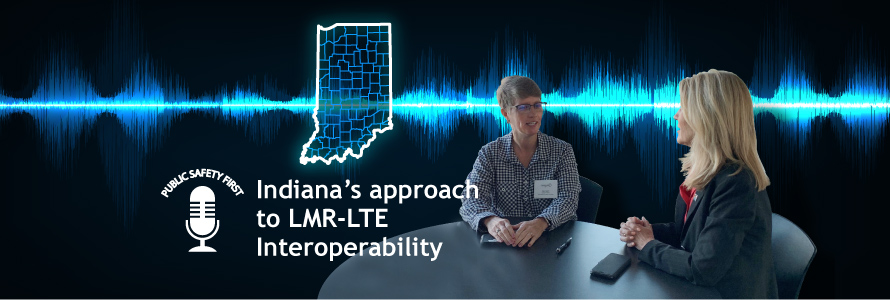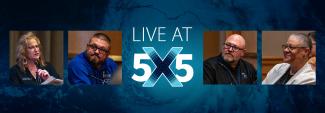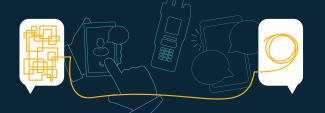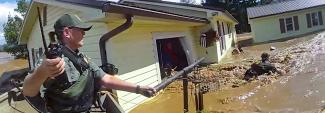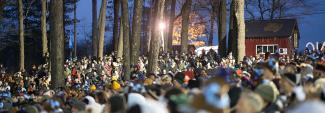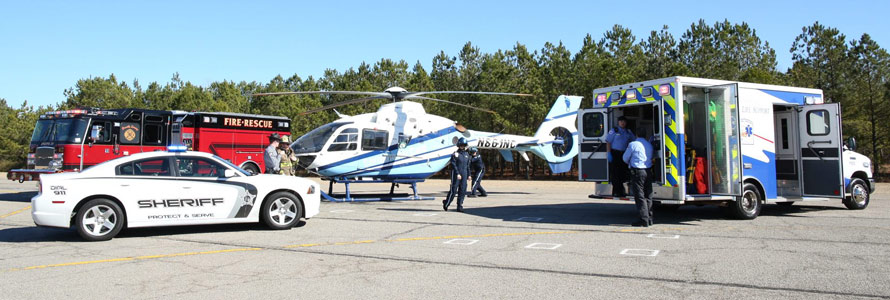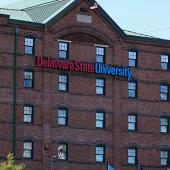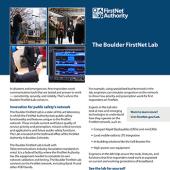Summary
Indiana’s Integrated Public Safety Commission worked to integrate the state’s land mobile radio system with FirstNet to enhance coverage, achieve significant cost savings, and expand capabilities for the state's first responders.
Guest
Lesia Dickson
FirstNet Authority Director of Field Operations for the Northcentral Region
Kelly Dignin
Executive Director of the Indiana Integrated Public Safety Commission
Transcript
Preview
Dave Buchanan: Hi, this is Dave Buchanan and welcome to the Public Safety First podcast. The podcast you’re about to hear is part of our Roadmap podcast series, which provides more information about the FirstNet Authority Roadmap – our guide to the future of FirstNet.
As part of this series, we’re showcasing the six domains that provide the foundation for the Roadmap. Today’s episode dives into the Voice Communications domain, which focuses on working to ensure voice capabilities on FirstNet can interoperate with the thousands of LMR [land mobile radio] networks currently in use. In today’s episode, Lesia Dickson, FirstNet Authority Director of Field Operations for the Northcentral Region, speaks with Kelly Dignin, Executive Director of the Indiana Integrated Public Safety Commission, about how the commission is working to integrate the state’s LMR system with LTE. Thanks for listening!
Dave Buchanan: Hi, this is Dave Buchanan and welcome to the Public Safety First podcast. The podcast you’re about to hear is part of our Roadmap podcast series, which provides more information about the FirstNet Authority Roadmap – our guide to the future of FirstNet.
As part of this series, we’re showcasing the six domains that provide the foundation for the Roadmap. Today’s episode dives into the Voice Communications domain, which focuses on working to ensure voice capabilities on FirstNet can interoperate with the thousands of LMR [land mobile radio] networks currently in use. In today’s episode, Lesia Dickson, FirstNet Authority Director of Field Operations for the Northcentral Region, speaks with Kelly Dignin, Executive Director of the Indiana Integrated Public Safety Commission, about how the commission is working to integrate the state’s LMR system with LTE. Thanks for listening!
Narrator: You're listening to Public Safety First, a podcast to help you learn about the First Responder Network Authority and how you can be part of the future of public safety technology.
And now, your host.
Lesia Dickson: Hello, my name is Lesia Dickson, and I’m coming to you today from the Indianapolis Motor Speedway, and it’s been a great day today as we’ve attended the Need for Speed FirstNet Conference, put on by the Indiana Integrated Public Safety Commission [IPSC].
With me here today is Kelly Dignin, the Executive Director for IPSC. Welcome, Kelly.
Kelly Dignin: Thank you.
Lesia Dickson: We had the opportunity today to hear you talk about a project that I am very intrigued about as far as linking your LMR and your LTE systems. If you would, maybe start out by telling us your responsibilities in both LMR and LTE, and then I want to talk to you about how that project is going and what you hope to achieve from it.
Kelly Dignin: Sure. So, as you mentioned, I am the Executive Director of the Integrated Public Safety Commission. Indiana’s a little bit unique in that we have a commission set aside to address public safety communications. We’re not embedded in any other agency – we are our own agency. We have IC code – or Indiana Code – law that enacts us, so it gives us the power to oversee the public safety communications.
So, our first project, we refer to as Project Hoosier Safety, and that was to build out an 800 megahertz radio system, trunk system, so that we can have a statewide radio system for interoperability. So, currently, we have about 180 towers that manage, that cover all 92 counties, and then we have about 90,000 users who participate in that. Our phase two was to create a data interoperability project, and so we did that, and so we had a vendor selection, and now we have a hosted computer-aided dispatch mobile data and RMS [records management system] and jail tracker system, a full suite that allows our folks to share data back and forth.
And then also on the LTE side, we’re the agency that was tapped by the governor to be the State Point of Contact for the FirstNet opt-in or opt-out. Thankfully, we were the 25th state to opt-in, and so now I still remain as the State Point of Contact for the LTE side.
So one of the things that we’re doing is looking at how do we complement one another with the LMR to LTE? So there’s an application out, and I’m sure everyone’s heard about LMR to LTE. So, it’s land mobile radio and connected to long term evolution, or the cell phone. So, we’re looking at doing this via ISSI port, so we’re going to connect our radio system, our P25 [Project 25] radio system, ISSI port using an advanced virtual private network connection to FirstNet. So, it gives us redundancy and backup to our system, and it also helps us to save money. So, we can have this app that sits on our phone that we can use to talk on the radios, gives us situational awareness for our admin so we don’t have to buy them high-dollar radios just for situational awareness, but we also have learned after talking to many of our first responders, that the LMR to LTE augments – and that’s my biggest surprise and the biggest interest – is that it augments our already public safety communication.
Because the LTE system operates off of WiFi along with the cell towers, it enhances our coverage. So, for example, our school safety resource officers – the schools in Indiana have police officers who are embedded in the schools. You get into those schools, those brick buildings, that’s usually very difficult for those radios to come out of those systems or those buildings. So with the LMR to LTE, they can have an LTE device that connects to the WiFi of the school that then they can talk back. So, it augments that public safety communication. The interesting thing that we’re finding is the emergency buttons translate back through the LTE system, onto the LMR, back to dispatch, so we don’t lose that functionality. They also have the ability to scan on their LTE device through the LMR system. So, it’s really robust, and it’s enhancing our officers’ safety.
Another scenario we were given is police chiefs who sometimes go to meetings or go out on events and they don’t carry that radio with them, and they lose a little bit of touch. They now won’t because they’ll have that LTE device that’s monitoring the radio system for them. So, it’s really amazing what we’re learning with our workshops and the conference here today and the interest we have. So, we believe it will help save lives and help save money, augment and assist in our LMR system.
Lesia Dickson: Well, that is really exciting, and, you know, LMR and LTE integration are something that’s happening quite commonly now, but what I was most intrigued about was the fact that you took a statewide approach, that I’d like you to talk a little bit more about what you see that bringing to Indiana and to different types of agencies as well.
Kelly Dignin: So, we’ve met with a few agencies over the month of August. We’ve conducted six workshops, and during those workshops, we’ve met with agencies to determine how could we do this, what’s its benefits, and the biggest thing that we’re noticing is how it’s going to save money. So, we have agencies currently – state and local agencies – who are looking to build in-building repeaters so that their radios can communicate back to us. Well, they won’t need to do that. So, I’ve had two agencies come up and say, “Hey, a quarter million dollars, half a million dollars I don’t have to spend now.” We have another agency in the Department of Corrections who is really, seriously looking at this because that’s extra radios they don’t need for situational awareness.
So, the biggest thing, though, that we want people to know is this is a complement to the LMR, it’s not a replacement of the LMR. We’re not asking you to take radios out of the hands of our first responders, but it can actually enhance their safety. So, we believe that it’s going to be a complement.
Lesia Dickson: Well, I was certainly impressed with the interest at both the regional conferences and here as far as the people that seem to be really open to this idea. Are you getting good response? Have you gotten a lot of people interested in doing this with you?
Kelly Dignin: Yeah, the interesting thing was that we did a survey to ask our local folks, “What is it you want to hear, and how do you want us to bring it to you?” The survey said, “We want regional meetings, and these are the information we want.” LMR to LTE was at the bottom of the list. Only two percent said, “Yes, we want to hear about it.” But I think it is such a big game changer that they want to hear about it, they just don’t know it yet. So, at the end of each workshop, I slipped a ten-minute presentation in, and it actually was the one presentation we got the most buzz out of, the most people walked up to me and gave me their card and said, “I’m in. I want this now. How do I get it?” It was all about LMR to LTE. So it’s, a lot of energy is being generated over this.
Lesia Dickson: So, how many users do you have on the LMR system today, and –
Kelly Dignin: Nearly 90,000.
Lesia Dickson: Wow, that’s a big system. So, a lot of those, you potentially see as being involved in the combination –
Kelly Dignin: I believe so.
Lesia Dickson: – of LMR and LTE?
Kelly Dignin: I believe so. And like I said, it’s because we discovered in talking to them, we’re not proposing you leave your LMR system.
Lesia Dickson: Right.
Kelly Dignin: It’s not a competitor. It’s a partner, and so, having both of them, especially for many of our police officers who are rural officers –
Lesia Dickson: Mm-hmm.
Kelly Dignin: – who don’t have the coverage on the radios. I don’t like to call them dead spots. I like to call them “low coverage areas.” I never want to send my first responder into a dead zone, so, if they go into a low coverage area, they have that LTE system to back them up.
Lesia Dickson: Right.
Kelly Dignin: Our school resource officers – it enhances safety in our schools from day one. So, we see it as a complement, and because of that, we’re getting so much people who are saying, “I’m in. I want that.”
I have a list of today, from today’s conference, of people who said, “Here’s my name, here’s my email, I’m in.”
Lesia Dickson: That’s exciting. So, in terms of the system itself, how long do you think it will be before you’ll be able to offer this?
Kelly Dignin: We’re hoping by the end of the year.
Lesia Dickson: By the end of the year?
Kelly Dignin: By the end of the year.
Lesia Dickson: So we’re coming up quick.
Kelly Dignin: Yes.
Lesia Dickson: That is really exciting.
The presentation that you did spelled out some benefits, and I think we’ve talked about a lot of those, but you also talked about the cons, if you will. The pros, you know, potential to save money, to expand coverage, lots of different things there, but what are the things that we also need to consider on the negative side?
Kelly Dignin: Yeah, so, one of the number one con to this, this is new technology. It is still being developed, not really ready for “prime time,” as we call it. It’s not mission-critical-reliable today, so that’s why I’ve pressed our staff to keep reminding people, do not take radios out of the hands of our first responders. So, those boots-on-the-ground folks, we want them to continue to have their radios. This is just to complement that, or for admin staff. So it’s not completely reliable yet, sometimes the network drops, and we need to make sure that they have those radios still in their hand. So, that’s one of the cons. We hope that in years to come, it’ll become more reliable, but for right now, it is not.
Also, the other thing is, one of the big takeaways for me is the talk ID doesn’t come across the LMR system. So, if I pick up my radio and talk on my radio, I either, as a former dispatcher, I have to – my ears tune to recognize people’s voices.
Lesia Dickson: Sure.
Kelly Dignin: So, I can recognize a voice and go, “Oh, I know who that is.” The phone won’t tell me who it is. Only my system ID appears. The person’s radio ID won’t. So, I either have to pay attention and make sure I catch that radio ID, or I have to recognize that voice. So, we’ve already pitched that back to the groups who are developing these. We want to see that ID to go back and forth.
Another con is location-based service. So, on my LTE device, if it’s LTE to LTE, I know where everybody’s at, but the location from that land mobile radio doesn’t come across that device, and vice versa. So, we want to make sure that, hopefully in the future they’ll develop that, but location services don’t translate back and forth across either.
Lesia Dickson: And those are good points for our Roadmap, because as we hear these kinds of things that you run into, and you making the service really usable, you know, we can hopefully spur some of that discussion, as well.
So, the features of the system that are coming, you mentioned a few others in your presentation, and I was just wondering if you could, kind of, recap some of the additional features and administrative functions that you see –
Kelly Dignin: Sure.
Lesia Dickson: – being benefits.
Kelly Dignin: One of the biggest – biggest advantages I see is that on the land mobile radio side, I only have an infinite number of talk groups. So, when I have a, come up with a 205, or my communication plan, I usually will have pockets of specialty or strike teams that say, “I need my own talk group,” or, “I need my own frequency.” And I won’t have one for everyone, so we have to do things to make it work. Where on the LTE side, I can build out as many talk groups as I want.
Lesia Dickson: Terrific.
Kelly Dignin: So if these are in their hands, I can build out for strike teams talk group just for them that will run across the LTE side and take that weight off my land mobile radio, so it’s another complement. So, I see that as a big advantage.
There’s also a feature that’s called the CAT Tool, and that is the administrative tool to manage this. I don’t have to type in everybody’s name and phone number, and any time there’s a new talk group available, I don’t have to touch every device. From that CAT Tool, I can push out, here’s the names and phone numbers of your colleagues that you’re going to be working with, and they’ll come up in your address book automatically. If I have that talk group I create, I just push it out and it shows up. I don’t have to touch every device. So, it’s going to make managing these devices so much easier for administrators.
Lesia Dickson: That’s great, that’s great. One of the things that we see out there, you know, generally in the industry is kind of a, almost a contentiousness between, you know, LMR and LTE, as if they’re a choice, one or the other, and I don’t feel that that’s something that is involved here, it seems like that’s, kind of, spurring some of this innovation. If you were talking to another state about this, what would you think would be the advantages of bringing those close together?
Kelly Dignin: Well, like I said earlier, they’re not competitors, it’s more of a partnership. I have areas within the state that have low coverage, where that LTE device can augment that. I have officers, firefighters, who are going inside buildings that the radio system just is not going to reach. So, that LTE device can work off the WiFi, and it resolves that low coverage area. They complement one another, they’re not a competitor. They both need to be up and running, they both need our attention, they both need to be planned.
Another advantage is, again, you’re going to have these disasters occur, and people are going to want more talk groups. Our land mobile radio cannot just have – the more talk groups you have on the trunk system, the greater your chances of having a busy. So, if I can offload some of that conversations onto an LTE talk group, LTE to LTE, we won’t have those busies. So, they can complement us and we can build that into our operational plan. We need them both.
Lesia Dickson: Well, I know that our number one goal is to, you know, save lives, to enable responders to be safer, and to do their job better, but there’s always that budget that’s hanging over everyone’s head. Tell me what this means in terms of money and budget for the users in Indiana.
Kelly Dignin: So this – we’re really, really early in this, so the numbers are just based on the six working groups we did. So, when we did our working groups, there were six working groups across the state of Indiana, two in the northern part, two center, two south, and we just said, I took that 15 minutes and said, “I know you don’t want to hear about it, but I’m going to tell you anyway.” And then I asked the question, “How do you think this can help you save lives, and how do you think this can help you save money?”
So, we got a lot of feedback. I came back with a whole new outlook on what this is going to be as far as saving lives, and that those workshops made me realize it is so much more of an augmentation to our LMR system. But when we walked away from it, hearing the in-building repeater projects, and how much those are costing, how many admins have radios, just to hear, but they don’t really talk and they’re not in harm’s way, and that we can give them a 99-cent FirstNet device rather than having a thousand-dollar radio.
So, preliminarily, talking to some of our state agency partners along with our local agencies, we were able to pretty much just say right off the top of our heads, we believe five to six million dollars can be saved in Indiana.
Lesia Dickson: Wow.
Kelly Dignin: That’s a lot of dollars.
Lesia Dickson: That’s a lot of dollars! And that’s a lot of dollars you can spend on some other –
Kelly Dignin: Exactly.
Lesia Dickson: – aspect of public safety.
Kelly Dignin: That’s exactly what I was going to say. That’s a lot of dollars that we can put back to our first responders.
Lesia Dickson: Right.
Kelly Dignin: And this really is, things our first responders – this can solve problems our first responders shouldn’t even have to think about. When they’re approaching cars, when they’re going into these buildings with low coverage, they shouldn’t have to worry about: “Am going to be able to talk back to my dispatch center?” They should just be thinking about their safety. So, I believe this is a solution to help that.
Lesia Dickson: Well, it sounds like it’s really going to be a big step for Indiana, and I hope other states will hear what you’re doing and look at doing this themselves in terms of expanding their, the things that they offer to their users and giving them more choice, and it sounds like that was a really positive thing. I heard a lot of good things here about that, so.
Kelly, really appreciate your time today, and thank you so much for telling us about this, and we’ll be watching this, and as it rolls out later this year, maybe we’ll have you back.
Kelly Dignin: Alrighty, thank you.
Lesia Dickson: Thank you.
Narrator: Thanks for listening today. We're excited to have you join our podcast community. Make sure to subscribe on iTunes, SoundCloud, and YouTube. You can learn more about the First Responder Network Authority at FirstNet.gov and learn about FirstNet products and services at FirstNet.com.


